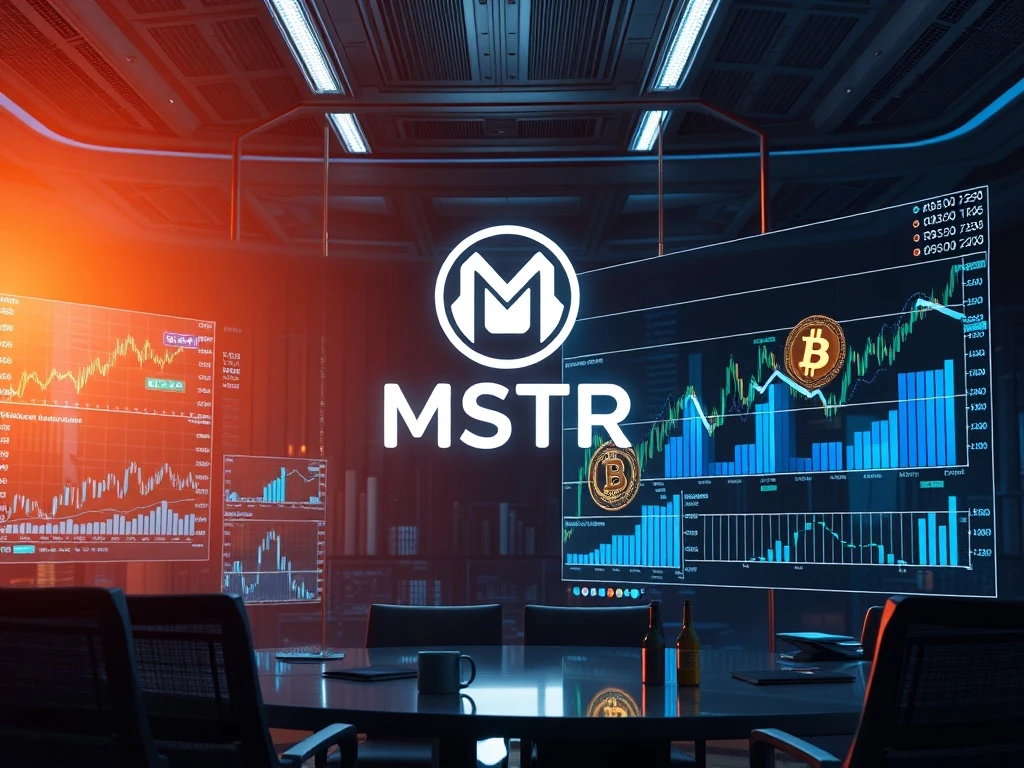Bitcoin Treasuries: The Strategic Revolution in Corporate Finance

In the dynamic world of corporate finance, a groundbreaking experiment is reshaping how companies manage their capital: leveraging intricate financial structures to build significant Bitcoin Treasuries. This bold shift, spearheaded by pioneers like MicroStrategy, signals a new era where digital assets are no longer just speculative plays but foundational elements of corporate balance sheets. But what does this mean for investors, and how can one navigate the tantalizing opportunities alongside the profound risks?
The MicroStrategy Blueprint: Pioneering Corporate Bitcoin Strategy
MicroStrategy (MSTR) has emerged as the poster child for this innovative approach, fundamentally redefining its identity by accumulating billions in Bitcoin. Their Corporate Bitcoin Strategy hinges on a sophisticated recursive capital-raising model. By 2025, MicroStrategy had executed a substantial capital-raising plan, splitting funds between common stock and fixed-income securities.
- Instrumental Diversity: Convertible notes, perpetual preferred shares (STRK and STRF), and At-The-Market (ATM) offerings form the core of their fundraising.
- Volatility Exploitation: These instruments capitalize on MSTR’s stock volatility, which often trades at a significant premium to its net asset value (NAV). This creates a self-reinforcing cycle: rising Bitcoin prices boost investor confidence, enabling more capital raises and subsequent BTC purchases.
- Managed Leverage: Despite the aggressive strategy, their leverage ratio (Debt + Preferred Equity)/Market Cap) stood at a moderate 9%, lower than initial projections. This reflects both market confidence and the company’s ability to price instruments effectively through embedded optionality.
The company’s success with its MicroStrategy Bitcoin holdings showcases how a focused, long-term commitment to digital assets can reshape a company’s financial narrative.
Regulatory Tailwinds and Navigating Bitcoin Investment Risks
The year 2025 has seen a significant shift in the regulatory landscape, leaning favorably towards Bitcoin. Under the Trump administration, executive orders and legislative actions, such as the rescission of the IRS “broker rule” and the establishment of the U.S. Strategic Bitcoin Reserve, have elevated Bitcoin’s status as a strategic asset. The SEC’s Crypto Task Force has further streamlined oversight for stablecoins, staking, and DeFi, easing compliance burdens for firms.
However, this pro-crypto environment doesn’t eliminate inherent Bitcoin Investment Risks. Bitcoin’s price volatility remains a significant concern. While appreciating BTC values amplify corporate holdings, a bear market could trigger liquidity crises. For instance, MicroStrategy’s model relies on sustained BTC appreciation; a sharp price drop could strain its debt obligations and erode its stock premium.
Furthermore, the concentration of Bitcoin in a few major players, like MicroStrategy’s substantial holdings, raises systemic risks. A distress event at such a firm could destabilize broader markets, particularly if panic selling amplifies volatility.
Institutional Adoption: The Rise of Bitcoin Treasuries
Institutional investors are increasingly integrating Bitcoin into their core portfolios, often allocating 5–10% to digital assets. The approval of Bitcoin ETFs, such as BlackRock’s iShares Bitcoin Trust (IBIT), has provided a regulated pathway for this participation. In 2025, U.S.-based investors poured billions into Bitcoin ETFs, signaling a shift from speculative exposure to strategic allocation.
Pro-crypto jurisdictions are also innovating with structured products. Tokenized real-world assets (RWAs) and cross-margining platforms allow institutions to hedge Bitcoin exposure through futures, options, and yield-generating strategies. The U.S. Strategic Bitcoin Reserve, capitalized by forfeited Bitcoin, further underscores the institutionalization of the asset. These strategies, while promising, demand careful risk management, as leverage and complexity can amplify losses during market downturns.
Unlocking Crypto Capital Innovation: Beyond MicroStrategy
The strategies pioneered by MicroStrategy are just one facet of broader Crypto Capital Innovation. This involves exploring new ways to leverage digital assets for corporate financing, treasury management, and even operational efficiency. Beyond direct Bitcoin accumulation, firms are looking at:
- Tokenized Debt: Issuing debt instruments on blockchain for greater transparency and efficiency.
- DeFi Integration: Utilizing decentralized finance protocols for borrowing, lending, and yield generation with corporate assets.
- Strategic Partnerships: Collaborating with crypto-native companies to build robust digital asset frameworks.
This evolution extends beyond simply holding Bitcoin; it’s about integrating the principles of decentralized finance and blockchain technology into traditional corporate structures, unlocking new avenues for growth and capital efficiency.
Navigating the Landscape: Key Risk Evaluation for Corporate Bitcoin Strategy
The primary risks of Bitcoin-driven capital structures revolve around three pillars:
- Price Volatility: Bitcoin’s historical price swings, including significant corrections, pose existential threats to leveraged portfolios. A substantial drop in BTC’s value could significantly impact equity premiums.
- Leverage Sustainability: The reliance on convertible debt and ATM offerings assumes continued investor appetite for volatility-linked instruments. A loss of confidence, triggered by regulatory shifts or market fatigue, could halt capital raises.
- Regulatory Shifts: While the 2025 pro-crypto climate is favorable, future administrations may adopt stricter frameworks. Ongoing SEC oversight of crypto asset securities, for instance, could reintroduce compliance burdens.
Actionable Insights: Investment Advice for the Digital Age
For retail investors, the key is diversification and risk mitigation. While Bitcoin’s long-term potential is compelling, direct exposure to leveraged corporate treasuries (e.g., MSTR) should be a small portion of a broader portfolio. Hedging tools, such as Bitcoin options or ETFs, can provide downside protection.
For institutional investors, the focus should be on structured allocation. A balanced model—perhaps 60% core Bitcoin and Ethereum, 30% satellite altcoins and DeFi, and 10% stablecoins and RWAs—offers a diversified approach. Additionally, institutions should explore cross-border opportunities in pro-crypto jurisdictions like Singapore or the UAE, where regulatory frameworks may be more accommodating.
Conclusion
The Bitcoin Treasuries innovation, particularly as exemplified by MicroStrategy, marks a paradigm shift in corporate finance. Its long-term success hinges on skillfully navigating a high-stakes environment where volatility, leverage, and regulatory dynamics intersect. For investors, the path forward demands a nuanced understanding of these risks, coupled with disciplined portfolio management. As the digital asset ecosystem matures, the ability to balance innovation with caution will determine long-term outcomes in this transformative arena.
Frequently Asked Questions (FAQs)
What is a corporate Bitcoin treasury?
A corporate Bitcoin treasury refers to a company’s strategy of holding a significant portion of its reserves or capital in Bitcoin, often acquired through various financing methods like debt or equity offerings, rather than traditional fiat currencies or conventional assets.
Why are companies like MicroStrategy investing heavily in Bitcoin?
Companies like MicroStrategy invest heavily in Bitcoin for several reasons: as a hedge against inflation, a store of value, a potential long-term appreciation asset, and a way to innovate their capital structure. They believe Bitcoin offers a superior alternative to traditional treasury assets in a low-yield environment.
What are the main risks associated with corporate Bitcoin treasuries?
The primary risks include extreme price volatility of Bitcoin, the sustainability of the company’s leverage model used to acquire Bitcoin, and potential adverse shifts in the regulatory environment. A significant drop in Bitcoin’s price could strain a company’s finances and erode shareholder value.
How do regulatory changes impact corporate Bitcoin strategies?
Regulatory changes can significantly impact corporate Bitcoin strategies. A favorable regulatory environment, such as reduced compliance burdens or official recognition of Bitcoin as a strategic asset, can encourage adoption. Conversely, stricter regulations or increased oversight could raise operational costs and deter investment.
How can investors mitigate risks when considering companies with Bitcoin treasuries?
Retail investors should consider diversification and limit direct exposure to highly leveraged companies. Utilizing hedging tools like Bitcoin options or ETFs can provide downside protection. Institutional investors should focus on structured allocation models and explore cross-border opportunities in pro-crypto jurisdictions to manage exposure and optimize returns.









